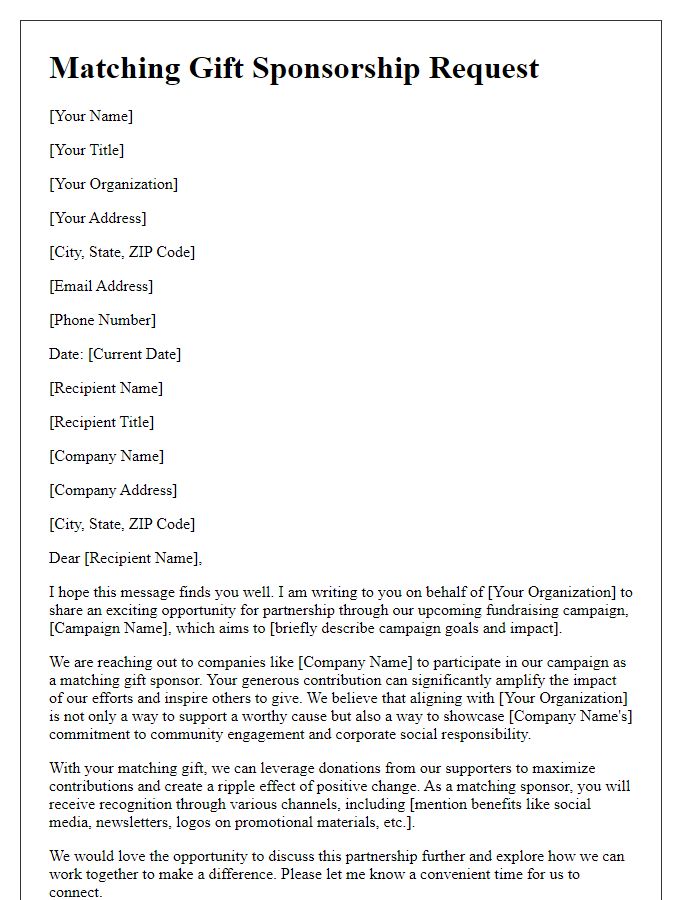Are you looking to make a difference in your community? Fundraising sponsorships are a fantastic way to rally support for a cause close to your heart while engaging local businesses and organizations. In this article, we'll explore effective strategies for crafting a compelling sponsorship request letter that resonates with potential partners. So, let's dive in and discover how you can inspire generosity and support in your fundraising efforts!

Clear Purpose Statement
A clear purpose statement is vital for effective fundraising sponsorship requests. It succinctly conveys the mission of the initiative, such as supporting community programs or advancing research in specific fields. The statement should outline the funding goals, such as raising $50,000 to support local educational initiatives in underserved areas. It is essential to include the target audience, aiming to impact approximately 300 children and families in the region. Highlighting the benefits for sponsors, such as brand visibility through event marketing materials and community recognition, enhances the appeal. This focused approach not only informs but also inspires potential sponsors to contribute to the cause, aiding in achieving the overall objectives for community betterment.
Donor Benefits
Crafting a compelling fundraising sponsorship request can significantly enhance donor engagement. A clear outline of donor benefits is essential in showcasing the advantages of sponsorship. Visibility options may include logo placement on event materials, social media mentions, and website recognition, reaching thousands of potential customers. Networking opportunities at events provide a chance to connect with community leaders, influential attendees, and other sponsors, fostering relationships that could benefit future business endeavors. Additionally, exclusive access to donor appreciation events ensures sponsors feel valued and recognized for their contributions. Tax-deductible donations enhance the financial appeal, providing sponsors with potential financial advantages. A robust marketing strategy can showcase sponsors' community involvement, aligning their brand with positive social impact and building goodwill among consumers.
Emotional Appeal
Nonprofit organizations often seek funding through sponsorship requests to support vital community projects. Emotional appeals can significantly enhance the effectiveness of these requests. For instance, local charity events in December (such as holiday food drives) can evoke feelings of generosity during the festive season, encouraging potential sponsors from businesses like grocery stores and restaurants to contribute. Personal stories highlighting individuals affected by the charity's work can resonate deeply, making the cause feel more relatable. References to specific dollar amounts needed (such as $5,000 for supplying meals to 300 families) can provide tangible goals, motivating sponsors to support the mission. Furthermore, statistics showcasing the impact of previous donations, such as increased community engagement (like 30% more volunteers in 2022), emphasize the tangible benefits of sponsorship, fostering a connection between the sponsor's contribution and the positive change within the community.
Call to Action
Non-profit organizations often seek sponsorship to support events such as charity runs, golf tournaments, and community festivals. In 2023, a local charity event in New York City aims to raise $50,000 for underprivileged children through educational programs. Sponsorship opportunities include branding on promotional materials, event t-shirts, and social media shout-outs reaching an audience of over 10,000 participants. Engaging local businesses can create goodwill while enhancing community visibility, potentially leading to increased customer loyalty. Contributions directly impact children's lives, fostering a brighter future through education and resources. Support from businesses in this initiative not only helps the cause but also creates a positive community image.
Contact Information
In fundraising sponsorship requests, clear contact information serves as the cornerstone for establishing communication between organizations and potential sponsors. Important elements include the organization's name (such as "Community Youth Programs"), address (for example, "123 Giving Lane, Hometown, ST 45678"), phone number (e.g., "555-123-4567"), and email address (like "info@communityyouthprograms.org"). Additionally, including a website link (such as "www.communityyouthprograms.org") enhances transparency and provides potential sponsors with access to further information on programs and impact. Social media handles (for platforms like Facebook or Twitter) can also be included to engage sponsors on various online platforms. This comprehensive approach creates an effective touchpoint for collaboration and partnership opportunities.
Letter Template For Fundraising Sponsorship Request Samples
Letter template of individual donor sponsorship request for charity drive

Letter template of community sponsorship request for local fundraising initiative

Letter template of non-profit organization sponsorship request for event support

Letter template of matching gift sponsorship request for fundraising campaign

Letter template of educational program sponsorship request for fundraising

Letter template of gala dinner sponsorship request for fundraising efforts








Comments